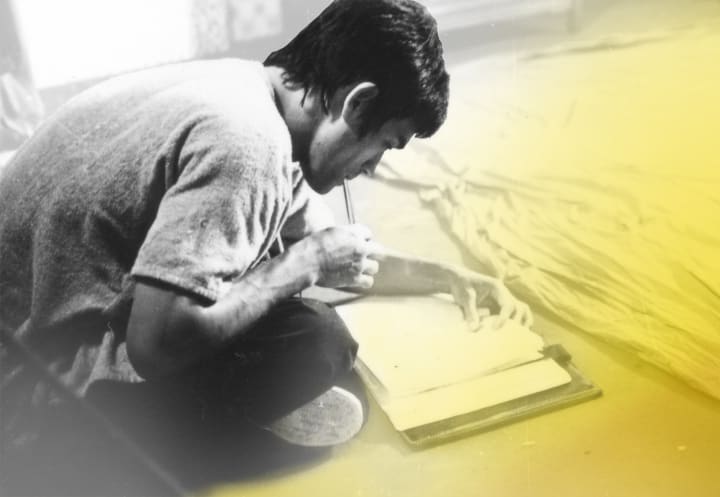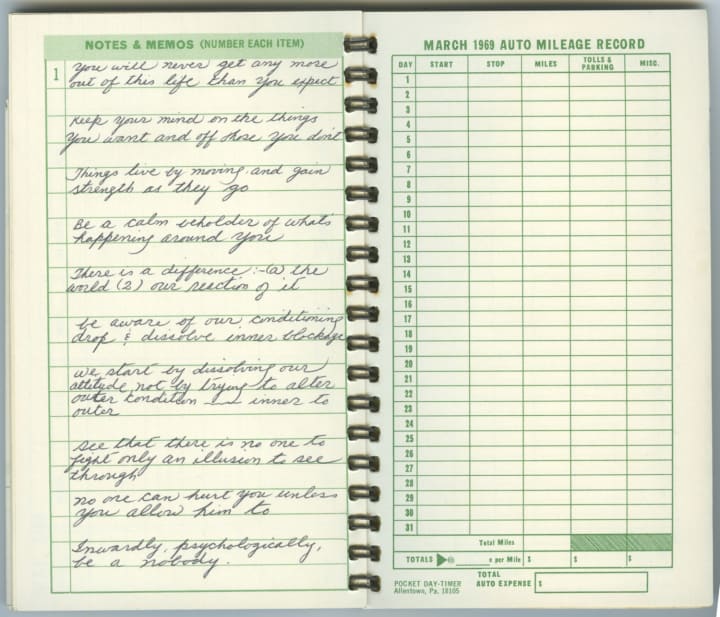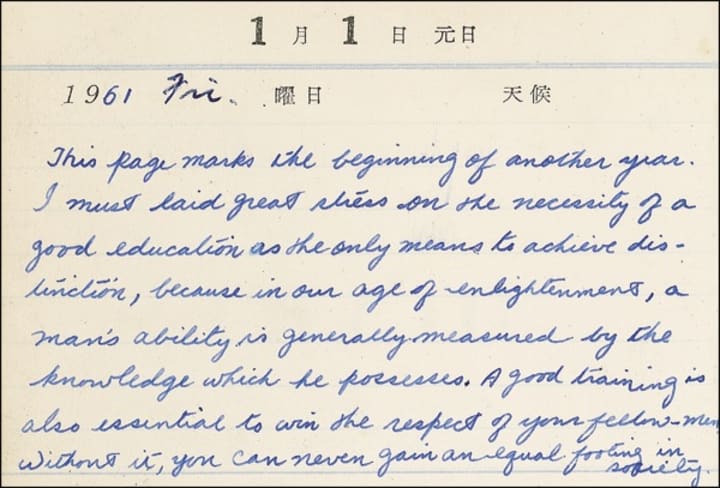Like Waves on the Ocean
Calming the mind waters eases mental chattering, with Bruce Lee

"Looking at the sky I can distinguish a smaller star because of the big stars, and if there were no black sky at all, there would be no stars. It is not a matter to struggle between the good and the bad, but to flow like waves on the water." — Bruce Lee
"Even better than flowing like waves on the water? Going beneath the surface, to the calm depths below." — Neil Spencer
Water plays a key function for all life to flourish on Earth. In some organisms, up to 90% of their body weight comes from water. Up to 60% of the human adult body is water, with aprticular organs having a higher concentration, and
Ocean conditions, are much like the conditions of our minds. When the sea is turbulent, with strong winds, and stormy seas, you're in for a rough ride — no matter how long you've been sailing. When the conditions are favorable, with the sun out and the wind at your back, you're in for a glorious day of smooth sailing.
How amazing would it be to have a weather forecast, or surf report, for our minds?
You wake up and check the report to see how the mind seas are going. Swell height, wind speed, tide (high or low), and water temperature. You check to see which of your favorite spots are worth getting up early to scope, or whether it's better to go back to bed.
Unfortunately, our minds don't have a dedicated surf report.
We have an idea about the swell height of our thoughts, sometimes we know the direction the winds of influence are coming (but not sure how they'll change), how deeply we're invested into our current course of thinking, and whether our mental state is positive (warmer), or negative (colder).
Using the metaphor of the ocean, the water content in our bodies, and the electricity (created by locomotion) running through it all —this article looks at water, and it's application to our internal, and external (mental and physical) states. Like waves on the ocean, calming the mind waters eases mental chattering.
1. Yoga and/or Martial Arts Practice

Having a dedicated physical practice is awesome for our health. It improves strength, flexibility, mobility, weight loss, improved blood circulation, improved waste management, and more.
Practicing yoga, and the martial arts, is great for clearing stagnant energy, and calming the waters in the body.
As mentioned above, up to 60% of the human adult body is water. One of our first steps in controlling the mind waves, is to start with a physical practice.
“Physical practice helps to move our attention from the chattering of the mind, to the movement of the body.” — Neil Spencer
By giving ourselves movement, eventually even the most chattering mind will have to quiet down and focus on the task at hand. Your mind may be quite distracted at the beginning, but once you warm-up, and get into the workout — something interesting happens: a moment of spacious quietness occurs.

The more time spent doing yoga and/or the martial arts, the more the practices have to do their magic. When you have some experience, instead of having to do an entire workout, a 10-15-20 minute routine of a few simple stretches and exercises can be all you need to begin feeling better right away.
One of the lesser well-known reasons we feel better, is explained in the bodies movement, which mimics a figure-8.
Figure-8 Movement (Infinity Symbol, Yin-Yang Symbol)

The movement, weight distribution and transfer in our bodies — is a figure-8. Which is also an infinity symbol. Which is a yin-yang symbol (to get this idea of the waves, turn the yin-yang symbol on it's side).
“One of the secrets of the symbol, is you have to imagine the retun line of the figure-8, which is missing in the symbol, but is there in practice and application.” — Neil Spencer
What makes it difficult to catch, is that it can be horizontal, vertical, or turned on any axis. It also doesn't keep a perfect 8-shape. It can be elliptical, and look like a 5-year old drew it. However accurate the shape, or not, our bodily movement creates a figure-8, infinity symbol, or yin-yang symbol when it: walks, practices yoga, meditation (why we cross our legs), or the martial arts (and more).
This idea is super important, because:
“One of the quickest ways to true, legit happiness, is movement.” — Neil Spencer
Which includes other froms, like (and keeping with the theme): surfing, skateboarding, surfskating, swimming, etc.
Locomotion in skateboarding, and newer surfskating (special board and trucks to emualte surfing on dry land), and actual surfing — all perform in this manner. Moving back and forth, weight distribution, and transfer — is how skaters and surfers create speed.


This is the body battery in action. Moving creates it's own energy. We are self-propelling. Because:
"We were intelligently designed for movement in the infinite."
— Neil Spencer
Soul Surfing

There's a reason why surfers love being out in the ocean, and always speak of the "soul," of surfing in a very particular way.
A soul surfer (term invented during the 1960s) is a surfer who surfs for the sheer pleasure of surfing. The term denotes a spirituality of surfing. As Brad Melekian stated in a 2005 article in Surfer magazine:
"to pursue surfing not just as an athletic endeavor or as a sunny day diversion, but to try to glean whatever lessons you can from the practice. It means being aware of your surroundings, and respectful of the people and places that you interact with. It means being patient, mindful, kind, compassionate, understanding, active, thoughtful, faithful, hopeful, gracious, disciplined and...good."
Skateboarding (Surfskating)

If you've ever been to a skatepark, you'll learn that skaters are — to most people's surprise — very kind and supportive of each other. Watching out for each other, teaching younger skaters beginner tips and tricks, and smacking the tail of their skateboard down whenever someone lands a clean trick.
It's because they're experiencing this phenomenon of figure-8, infinity, yin-yang movement energy — when they're out doing what they love. To experience infinity — right here, right now —just takes some effort to get yourself going; and, keeping up the momentum to continue moving.
2. Meditation
When we sit down, with our legs crossed, they create a figure-8, infinity, or yin-yang symbol. Just this sitting, and we're ready to be in touch with the infinite. Now, comes the tricky part — calming the seas of the mind, forgetting about the body, and going deeper to the calm depths below.
Turbulent Surf Conditions in Daylight

Sometimes, things happen which can really make the seas of our minds rough, with large waves, and precarious surf conditions; with the best looking waves breaking dangerously close to the shore, or onto a shallow reef.
This is when the chattering of the mind is affecting our waking lives. We are distracted, and lost in our own thoughts.
We could be lamenting over the past, or worrying about the future. In a state of anxiety, or agitation, our minds dart from distraction, to distraction. Opening social media apps to find something interesting to occupy a spare moment of boredom — to find yourself closing the app 10-20 minutes later — still bored, but spared the present moment.
"When a storm is brewing in the mind, and the wave thoughts are choppy, with a strong undercurrent; this is when you need to learn to go beneath the surface of the thought waves." — Neil Spencer
Meditation Exercise: Going Beneath the Mind Waves

If you're in the wrong place when a set of waves comes rolling through, and they crash on you — it can feel like being on the inside of a washing machine.
Scrambling, you ditch your board and dive beneath the wave as it comes over. Tossed about violently like a rag-doll, you're left not knowing which direction is up. You swim towards the light, only to have the leash around your ankle keep you under. Finally, frantically, you break the surface — only to see another wall of whitewash barreling down on you.
If you've ever been surfing, learning how to duck dive waves to get out into the lineup, is one of the first — and most important maneuvers — you'll ever learn. A duck dive, is when the nose of the surfboard is pressed underneath the water. A knee is used to keep the back of the board down as you press the board forward. Then, you tilt the nose up, and pull yourself through the wave.
There is a quiet spaciousness when you duck dive a wave. In that in-between is where you find peace.This peace can be found just as easily on the floor of your bedroom, or sitting on your beach towel in the warm sands — in meditation.
Visualization and Technique
Find a nice, quiet place to sit where you won't be disturbed for at least 15-20 minutes; and, move all distractions out of hands reach.
- Sit comfortably cross-legged (half, or full lotus if you can handle it).
- Keep the back and spine straight - no slouching.
- Breathing will be an even 1:1 ratio, in- and-out through the nose, with the mouth closed.
- The breath should be long, fine, and thin. With the aim of a five-second inhale, and five-second exhale.
- The goal is to extend the ratio over time, for ex. 10-second inhale, 10-second exhale; 20-second inhale, 20-second exhale.
- Put on some calming meditation music, relax, and begin breathing.
Piucture yourself out on the water, and a huge swell comes through. This is the chattering of your mind. Instead of trying to fight your way through the breaking waves, you have another idea: You're going to duck dive beneath the surface, and then keep swimming down.
You swim until you're well below the surface. You can still see the waves churning, and breaking above. You can even see the fins of a surfboard slice through the surface as someone takes off down a wave. You can see your hair floating around your head.
In this moment, you experience the calm of the deeper waters (And, there's no need to worry, you can breathe just fine underwater in meditation).
Here, you become the observer of your thoughts, habits, and actions. You finally have the space to see the waves on the surface, and get to experience the peace of the deeper waters below.
The surface is the waking mind of the ego, and the deeper waters are the subconscious mind. There's peace below the surface. There can also be some scary sea beasts in the subconscious mind as well. I remember listening to an Alan Watts talk, where he said something in the way of:
"The ocean waves waves." — Alan Watts

"Get below the surface, and deal with what lies in the deeper waters. The surface will calm itself in harmony and balance with the currents of the deep." — Neil Spencer
Which is true. Storms are created by the undercurrents of the deep, coming into contact with the weather at the surface. Calm the deeper waters, and you'll be better able to handle a surge of wind on the surface.
3. Mindfulness: Mindful Breathing, Mindful Walking; or, Mindful Breathing, Mindful Mindful __________.

The practice of taking yoga, meditation, and the martial arts — out of the studio, bedroom, or temple — and into everyday life situations, is really what mindfulness is all about.
Walking, is the simplest way to experience this phenomenon in action. Just takes a little concentration. Which can be trained and developed through mindfulness.
This is where the magic begins to take place. Ever so slowly, your practices begin to help mold and shape how you respond to the ups and downs of daily life — like the crest and trough of a wave.
"Mindfulness, sits somewhere between physical practice, and meditation." — Neil Spencer
You take your experience of settling the bodies energy, and calming the seas during yoga, meditation, or the martial arts; and apply those same principles, techniques, and philosophies to situations around you.
One of my all-time favorite training exercises, is: mindful breathing, mindful walking.

Bringing mindfulness into walking, differs from just going on a walk, in the sense that you are paying closer attention to your breathing. Breathing deeply on the inhale, breathing deeply on the exhale — you bring your attention to your breath, and your body — to the Here & Now.
Whatever is troubling you, can wait. You’re paying attention to the air coming in, and the air going out. It can even be a game of how full you can become on each inhale; and, how empty you can become on every exhale.
The secret ingredient in all of this, is to walk long enough for the breath and body movement to clear our emotions, and thoughts. According to Thich Nhat Hahn, in his book Anger, this is done with at least 20 minutes of mindful breathing, mindful walking — to create the energy of mindfulness.
"Mindful breathing and mindful walking generate the energy of mindfulness…so that you can transform your anger, your pain, and your suffering. The energy of mindfulness allows you to hold your anger gently, like a baby. We have to learn to take good care of our anger, so that we can transform it. It’s not up to the other. It is up to us. That is the miracle of our practice. Our practice creates Compassion - which is the antidote for our anger, and suffering." — Thich Nhat Hahn, Anger
You can be upset, annoyed, angry, hurt, frustrated; sad, lonely, or depressed — whatever is going on, can be helped tremendously with 20-minutes of mindful breathing, and mindful walking. This same practice can also be superimposed onto other practices you love and enjoy.
Dancing

I've found it really beneficial to have another practice, besides yoga or the martial arts, which brings me joy. We talked about the activites of skateboarding, and surfing above; but, I have another passion — which I share with tons of people — and it's dancing.
One of my all-time favorite things to do, is put on some headphones and dance in the backyard like no one is watching. Dancing, and the constant shifting back and forth — creates the same figure-8, infinity, yin-yang symbol patterning. The feet, ankles, knees, legs, hips, shoulders, hands, and arms move in the same figure-8 pattern — back and forth with the shifting and distribution of weight, for balance.
“You hear a beat you like, and you groove to it.” — Neil Spencer

Knowing how to dance is really special, because it allows you to shake and dance with the rhythms of life. You can feel the pulse, and rhythm of the drums on the dance floor. Learning to count the beats, you anticipate the changes in the synth patterns. And, you can't get any closer to the subwoofer to feel the bass rumble in your chest.
With practice, you learn how far to swing your weight one way, come in touch with the maximum, and then yield to return back.
"You never see anyone only dance in one direction, clear across the dance floor, and out the door." — Neil Spencer
If you’re not the best dancer, but still curious about this phenomenon, watch a DJ perform. Not only are they swaying back and forth to the rhythms, but most anyone standing in frame of the video is as well.
This is a perfect example below of Guy Gerber's DJ set in Ibiza for Boiler Room. Just watch everyone sway back and forth at this lovely, chilled out vibe of a daytime pool party.
5. Handwritten Study Notes

"As he lived before the age of home computers and photocopiers, Lee wrote notes, often verbatim transcriptions in longhand, from passages he found both true and helpful. Reviewing them would inspire him to further writing. These were his private journals, where Lee contemplated the thoughts of men and women of like mind."
It's known Bruce Lee is a cultural icon and martial artist. What's less well known, is Bruce Lee as prolific writer and philosopher. He journaled enthusiasticaly throughout his life, and was known for keeping a small notepad or book close by. Whenever inspiration struck, he was ready to jot down ideas, and notes.
What's really fascinating, is Bruce Lee believed philosophies are meant to be applied, and not just pondered on.
I believe this is why he would copy long sections verbatim by hand. He wanted to really get the philosophies which he thought to be good and true into his system. He then worked with them through his martial arts training. Discarding what didn't work for him personally, and keeping what did. Then, he started to create his own belief system, based off of his personal training experiences, and how certain philosophies complimented his training.


There have been many current research studies which look at how handwriting practice may improve literacy learning by engaging motor functions. This exerpt, is taken from a Norwegian University of Science and Technology study:
"The use of pen and paper gives the brain more 'hooks' to hang your memories on. Writing by hand creates much more activity in the sensorimotor parts of the brain," senior author Audrey van der Meer said in an October 2020 news release. "A lot of senses are activated by pressing the pen on paper, seeing the letters you write, and hearing the sound you make while writing. These sensory experiences create contact between different parts of the brain and open the brain up for learning. We both learn better and remember better."
When we engage our motor functions when it comes to writing, and learning — we learn and remember better. When we're handwriting, we have to focus more intently. The letters have to sit nicely between the lines, and if you're copying long quotes that are true and helpful like Bruce Lee did, there's quite a bit of memory going on. Constantly switching back and forth between book, or article, and journal.
When we concentrate, our breathing becomes fuller, deeper, smoother, finer, and gentler. The parasympathetic nervous system is activated. As our breathing begins to slow, our heartbeat slows as well; and, our thoughts begin to die down as the waves of our minds lose their agitating winds.
6. Letting Go / Non-Grasping

"It exists HERE and NOW; it requires only one thing to see it: openness, freedom — the freedom to be open and not tethered by any ideas, concepts, and so forth. We can go on rehearsing, analyzing, attending lectures, and so forth, until we are blue in the face; all this wil not be of the slightest avail — it is only when we stop thinking and let go that we can start seeing, discovering." — Bruce Lee
"When our mind is tranquil, there will be an occasional pause to its feverish activities, there will be a letting go, and it is only then in the interval between two thoughts that a flash of UNDERSTANDING—understanding, which is not thought—can take place." — Bruce Lee
This is one of the easiest pieces of advice to give, and one of the more difficult concepts to grasp in practice. When we're overthinking, with tons of conflicting ideas running around in our minds — we lack clarity. We disengage from the beauty, wonder, and awe of the present moment. Of creation as it is happening. Of nature, and our interconnectedness with all sentient beings.
Always grasping at this or that, always distracted and looking outside of ourselves for meaning and validation; we miss the most fundamental truth of the happiness which exists in the HERE and NOW — openness and freedom.
When our minds are open and free, they are clear. They are not weighed down by the foggy electricity usage of erratic thinking. We have no ideas, or concepts about this or that from society to cloud our thinking. It's like staring at nature with a blank slate.
Like the guys in the first Endless Summer — surfing some of the most epic surf spots in the world, with no one else out in the water.

In this tranquil state, and a pause in the mind's feverish activity, we can take anything which is bothering us, and let it go.
"When we let go of the mental chattering that is taking over the precious real estate of our minds; we see there is an interval between thoughts, just like the lull between waves. Where the roar and hiss of the crashing wave is muffled from the back, and the next wave is still whispering it's way to us." — Neil Spencer
In this interval between two thoughts, a flash of understanding can take place — understanding which is not thought.
This experience is what is sought by soul practitioners; and, it doesn't matter whether you're a yogi, martial artist, skateboarder, surfskater, surfer, swimmer, walker, runner, etc.
We push ourselves to the brink, just for a taste; and, like going beneath the waves on the ocean, calming the mind waters eases mental chattering.
If you'd like to stay in the loop for more radiance, subscribe through the link.
Sources:
- Lee, Bruce. Bruce Lee Artist of Life (Bruce Lee Library) (introduction) (p. 53). Tuttle Publishing. Kindle Edition.
- The Water In You: Water and the Human Body
- Surfline: Newport Beach Pier Surf Report
- Soul Surfer - Wikipedia
- Melekian, Brad. March 2005, "Is God a Goofyfoot?", Surfer, 46/3, p. 115.
- Carver Skateboards - Lost Rad Ripper
- Surfdock - Photo of girl surfskating
- Blackwing - Bruce Lee's Writings
- Brucelee.com: Bruce Lee's Philosophies
- Psychology Today - Why Does Writing By Hand Promote Better and Faster Learning?
- Eva Ose Askvik, F. R. (Ruud) van der Weel and Audrey L. H. van der Meer. "The Importance of Cursive Handwriting Over Typewriting for Learning in the Classroom: A High-Density EEG Study of 12-Year-Old Children and Young Adults." Frontiers in Psychology (First published: July 28, 2020) DOI
- Bruce Brown Films - Endless Summer Poster
About the Creator
Neil Spencer
Yoga Wizard / Teacher: Founder of Saumya Yoga
My name is Neil Spencer, and I teach yogis about that radiant "something," which gives everything it's beauty.
Vibes: Yoga, meditation, martial arts, mindfulness, cannabis, electronic house music






Comments
There are no comments for this story
Be the first to respond and start the conversation.